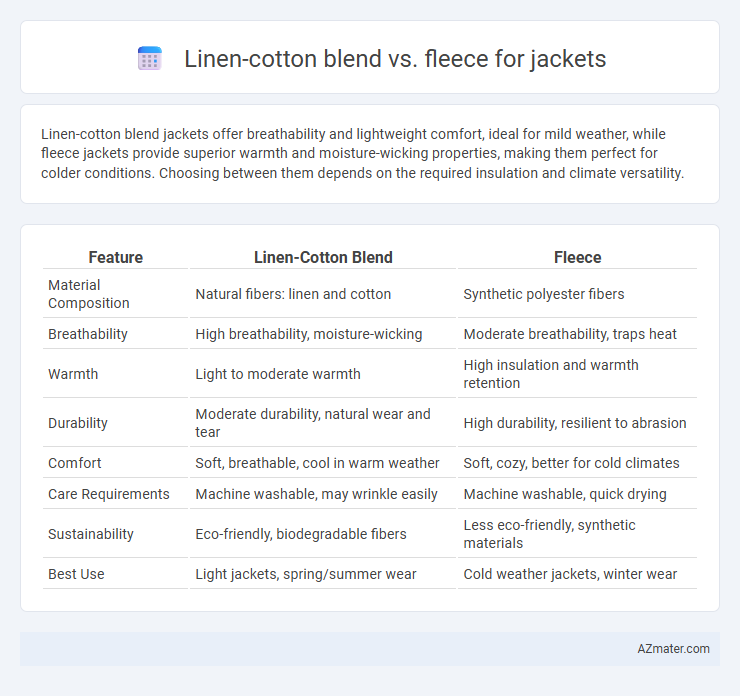Linen-cotton blend jackets offer breathability and lightweight comfort, ideal for mild weather, while fleece jackets provide superior warmth and moisture-wicking properties, making them perfect for colder conditions. Choosing between them depends on the required insulation and climate versatility.
Table of Comparison
| Feature | Linen-Cotton Blend | Fleece |
|---|---|---|
| Material Composition | Natural fibers: linen and cotton | Synthetic polyester fibers |
| Breathability | High breathability, moisture-wicking | Moderate breathability, traps heat |
| Warmth | Light to moderate warmth | High insulation and warmth retention |
| Durability | Moderate durability, natural wear and tear | High durability, resilient to abrasion |
| Comfort | Soft, breathable, cool in warm weather | Soft, cozy, better for cold climates |
| Care Requirements | Machine washable, may wrinkle easily | Machine washable, quick drying |
| Sustainability | Eco-friendly, biodegradable fibers | Less eco-friendly, synthetic materials |
| Best Use | Light jackets, spring/summer wear | Cold weather jackets, winter wear |
Introduction to Linen-Cotton Blend and Fleece Jackets
Linen-cotton blend jackets combine the breathability and natural texture of linen with the softness and durability of cotton, creating a lightweight, moisture-wicking fabric ideal for warm weather. Fleece jackets offer superior insulation and moisture resistance, made from synthetic fibers designed for warmth and comfort in colder climates. Choosing between linen-cotton blend and fleece depends on desired temperature regulation, breathability, and the specific outdoor activity.
Fabric Composition: Linen-Cotton Blend vs Fleece
Linen-cotton blend jackets are composed of natural fibers, offering breathability and moisture-wicking properties ideal for warmer climates or transitional seasons. Fleece fabric, typically made from synthetic polyester, provides superior insulation and softness, making it suitable for cold weather and activewear. The choice between linen-cotton blend and fleece fabric depends on the desired balance of comfort, warmth, and durability in jacket construction.
Breathability and Comfort: Which Wins?
Linen-cotton blend jackets excel in breathability due to the natural fibers that allow superior air circulation and moisture-wicking, making them ideal for warm weather or active use. Fleece jackets offer excellent warmth and softness, but they trap heat more and have lower breathability, which can lead to discomfort during prolonged wear or high activity. For optimal comfort in moderate to hot climates, linen-cotton blends win, while fleece suits cooler environments requiring insulation.
Insulation and Warmth Comparison
Linen-cotton blend jackets offer lightweight breathability but provide minimal insulation, making them suitable for mild weather rather than cold conditions. Fleece jackets excel in thermal retention due to their synthetic fibers trapping heat, delivering superior warmth and insulation in chilly environments. For cold weather, fleece remains the optimal choice, while linen-cotton blends are better suited for moderate temperatures where breathability is prioritized.
Durability: Long-Lasting Qualities
Linen-cotton blend jackets offer superior durability due to the natural strength and breathability of both fibers, making them resistant to wear and tear over time. Fleece jackets, while soft and warm, tend to have lower abrasion resistance and may pill or degrade faster with frequent use. Choosing a linen-cotton blend ensures a long-lasting, sturdy garment ideal for regular outdoor wear and extended durability.
Moisture Wicking and Absorption Abilities
Linen-cotton blend jackets excel in moisture absorption, drawing sweat away from the skin to keep you dry and comfortable in warm weather. Fleece, while less absorbent, excels in moisture wicking by quickly moving sweat to the outer fabric layer for evaporation, making it ideal for cold-weather activities. Choosing between linen-cotton blend and fleece depends on the desired balance between breathability and moisture management for specific climate conditions.
Style and Aesthetic Appeal
Linen-cotton blend jackets offer a lightweight, breathable fabric with a natural texture that enhances casual and sophisticated styles, providing a refined, crisp appearance ideal for spring and summer wear. Fleece jackets, made from synthetic fibers, emphasize warmth and comfort with a plush, soft texture, delivering a sporty, cozy aesthetic perfect for outdoor activities and colder conditions. The linen-cotton blend excels in versatility and contemporary elegance, while fleece prioritizes casual, functional style with a modern, relaxed vibe.
Eco-Friendliness and Sustainability
Linen-cotton blend jackets offer superior eco-friendliness due to their natural, biodegradable fibers and lower water consumption during cultivation compared to synthetic options. Fleece jackets, often made from polyester derived from petroleum, contribute to microplastic pollution and rely on non-renewable resources, making them less sustainable. Choosing linen-cotton blends supports reduced environmental impact through renewable farming practices and compostable materials.
Care and Maintenance Requirements
Linen-cotton blend jackets require gentle washing in cold water and air drying to prevent shrinkage and maintain fabric integrity. Fleece jackets are more durable, often machine washable and quick-drying, but may pill over time and need occasional de-pilling. Proper care for both materials extends jacket lifespan while preserving comfort and appearance.
Best Occasions or Activities for Each Fabric
Linen-cotton blend jackets excel in warm-weather activities and casual outdoor events due to their breathability and lightweight properties, making them ideal for spring and summer outings or casual office wear. Fleece jackets offer superior insulation and moisture-wicking abilities, making them the best choice for cold-weather activities like hiking, skiing, or camping where warmth and comfort are essential. Selecting a linen-cotton blend suits mild climates and stylish daywear, while fleece is optimized for active winter sports and layering under heavier outerwear.

Infographic: Linen-cotton blend vs Fleece for Jacket
 azmater.com
azmater.com